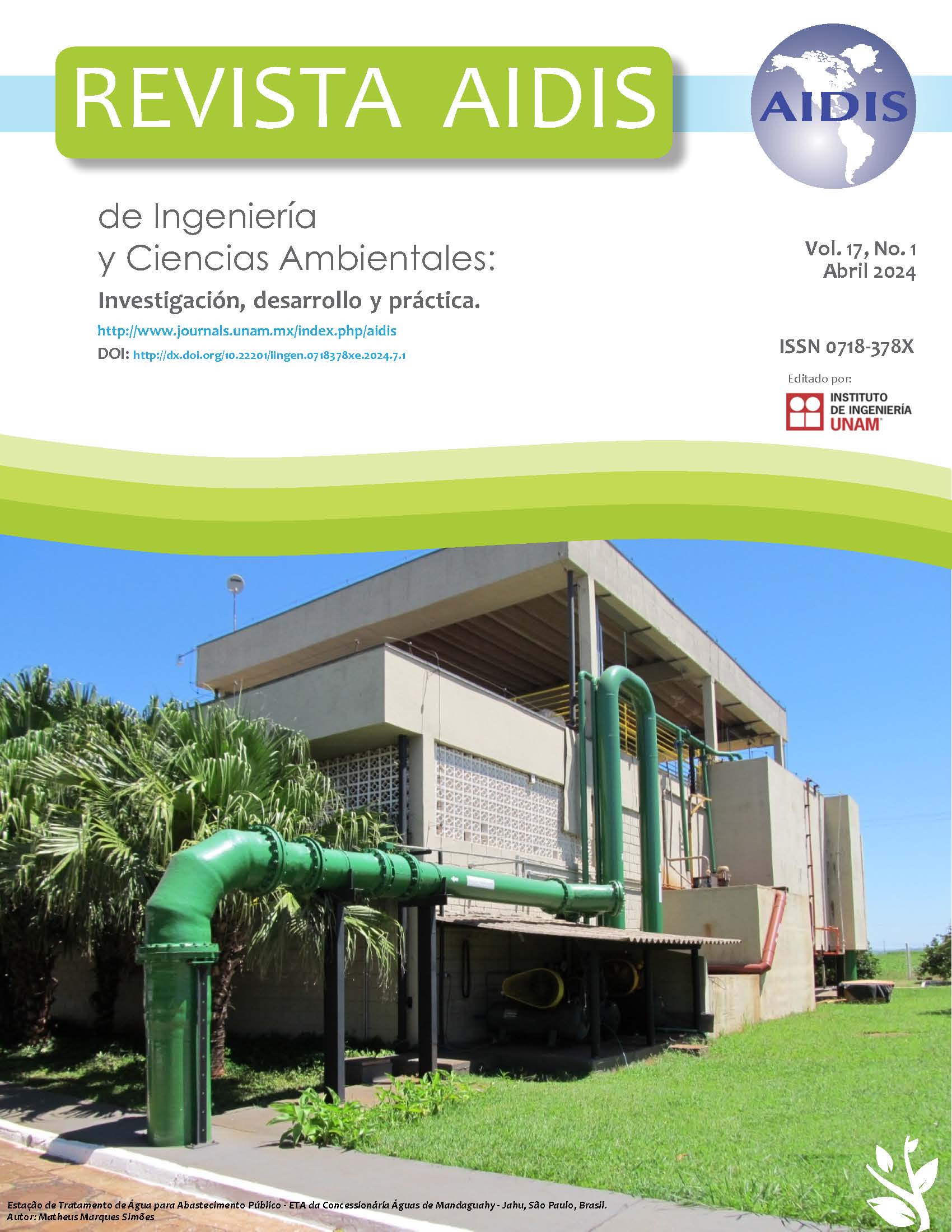Urban biomining: lithium recovery from spent batteries through multi-step bioprocesses
Contenido principal del artículo
Resumen
Multi-step design to evaluate the bio-recovery of lithium from spent batteries was studied. The first step consisted of lithium extraction from spent batteries, using bacterial and fungal acid extrolites. The second step explored lithium recovery in the form of carbonate salts by using MICP (Microbial Induced Carbonate Precipitation) bacteria from Sporosarcina species. For lithium extraction (Step 1) sulfuric acid produced by sulphur oxidizing bacteria Acidithiobacillus thiooxidans was evaluated for its capacity to leach lithium. Extraction with biogenic sulfuric acid and with fungal bio- produ-cts (from Aspergillus sp. and Simplicillum sp. isolated at our facilities) were compared with commercial sulfuric acid. For biorecovery processes (Step 2), two type strains of Sporosarcina sp. were tested due to their capacity to precipitate lithium carbonate. Results showed fungal bioextracts gave a lithium leaching yield close to 60% and a global recovery yield of 27%. These observations are reported for the first time and lay the foundations for continuing the study and scaling up of this combined process for lithium recovery.
Detalles del artículo
Citas en Dimensions Service
Citas
Amato, A., Becci, A. V.-G., M., Vereda-Alonso, C. B., F. (2021). Challenges for sustainable lithium supply: A critical review. Journal of Cleaner Production, 300, 126954. http://dx.doi.org/10.1016/j.jclepro.2021.126954
Boxall, N. J., Cheng, K. Y., Bruckard, W., Kaksonen, A. H. (2018). Application of indirect non-contact bioleaching for extracting metals from waste lithium-ion batteries. Journal of Hazardous Materials, 360, 504-511. https://doi.org/10.1016/j.jhazmat.2018.08.024
Brierley, C. L., Brierley, J. A. (2013). Progress in bioleaching: part B: applications of microbial processes by the minerals industries. Applied Microbiology and Biotechnology, 97, 7543-7552. https://doi.org/10.1007/s00253-013-5095-3
Buonomo, A., Higa., R. (2022). Procesos biotecnológicos mediados por microorganismos para la recuperación y reutilización de litio proveniente de baterías agotadas. Tesis de Grado. Licenciatura en Biotecnología, Universidad Argentina de la Empresa. Buenos Aires, Argentina.
Bustos-Gallardo, B., Bridge, G.,Prieto, M. (2021). Harvesting Lithium: water, brine and the industrial dynamics of production in the Salar de Atacama. Geoforum, 119, 177-189. https://doi.org/10.1016/j.geoforum.2021.01.001
Delbuono, V. S. T., Toledo, E., Jerez, D. (2017). Mercado de Litio: Situación actual y perspectivas. In: MINERÍA, Ministerio de Energía (Eds.). Argentina.
Editor's notes (2021). Lithium-ion batteries need to be greener and more ethical. Nature, 595. https://www.nature.com/articles/d41586-021-01735-z
Eyzaguirre, S. A. G. (2020). Oferta y demanda de litio hacia el 2030. In: Dirección De Estudios Y Políticas Públicas, Ministerio de Minería (ed.). Chile. Available at: https://www.cochilco.cl/Mercado%20de%20Metales/Produccion%20y%20consumo%20de%20litio%20hacia%20el%202030.pdf
Foster, M., Isely, P., Standridge, C. R.,Hasan, M. M. (2014). Feasibility assessment of remanufacturing, repurposing, and recycling of end of vehicle application lithium-ion batteries. Journal of Industrial Engineering and Management; 7(3). https://doi.org/10.3926/jiem.939
Frisvad, J. C., Larsen, T. O. (2015). Chemodiversity in the genus Aspergillus. Applied Microbiology and Biotechnology, 99, 7859-7877. https://doi.org/10.1007/s00253-015-6839-z
Frisvad, J. C., Møller, L. L. H., Larsen, T. O., Kumar, R., Arnau, J. (2018). Safety of the fungal workhorses of industrial biotechnology: update on the mycotoxin and secondary metabolite potential of Aspergillus niger, Aspergillus oryzae, and Trichoderma reesei. Applied Microbiology and Biotechnology, 102, 9481-9515. https://doi.org/10.1007/s00253-018-9354-1
Gajardo, G., Redón, S. (2019). Andean hypersaline lakes in the Atacama Desert, northern Chile: Between lithium exploitation and unique biodiversity conservation. Conservation Science and Practice, 1, e94. https://doi.org/10.1111/csp2.94
Gargarello, R., Cavalitto, S., Di Gregorio, D., Niello, J. F., HucK, H., Pardo, A., Somacal, H., Curutchet, G. (2008). Characterisation of uranium(vi) sorption by two environmental fungal species using gamma spectrometry. Environmental Technology, 29, 1341-1348. https://doi.org/10.1080/09593330802327069
Gentina, J. C., Acevedo, F. (2016). Copper Bioleaching in Chile. Minerals [Online], 6. https://doi.org/10.3390/min6010023
IEA, International Energy Agency (2021). Net Zero by 2050. Report. iea.li/nzeroadmap
Jain, N., Sharma, D. K. (2004). Biohydrometallurgy for Nonsulfidic Minerals—A Review. Geomicrobiology Journal, 21, 135-144. https://doi.org/10.1080/01490450490275271
Johnson, D. B. 2014. Biomining—biotechnologies for extracting and recovering metals from ores and waste materials. Current Opinion in Biotechnology, 30, 24-31. https://doi.org/10.1016/j.copbio.2014.04.008
Jones, B. A., F., Rodríguez, V. (2021). Cambios en la demanda de minerales: análisis de los mercados del cobre y el litio, y sus implicaciones para los países de la región andina. In: CARIBE, C. E. P. A. L. Y. E. (ed.) Documentos de Proyectos (LC/TS.2021/89). Santiago de Chile, Chile.
Kocsubé, S., Perrone, G., Magistà, D., Houbraken, J., Varga, J., Szigeti, G., Hubka, V., Hong, S. B., Frisvad, J. C., Samson, R. A. (2016). Aspergillus is monophyletic: Evidence from multiple gene phylogenies and extrolites profiles. Studies in Mycology, 85, 199-213. https://doi.org/10.1016/j.simyco.2016.11.006
Kumari, D., Qian, X.-Y., Pan, X., Achal, V., Li, Q., Gadd, G. M. (2016). Chapter Two - Microbially-induced Carbonate Precipitation for Immobilization of Toxic Metals. In: Sariaslani, S., Gadd, G. M. (Eds.) Advances in Applied Microbiology. Academic Press. https://doi.org/10.1016/bs.aambs.2015.12.002
Lambert, P. W., Meers, J. L., Best, D. J., Hartley, B. S., Atkinson, T., Lilly, M. D. (1997). The production of industrial enzymes. Philosophical Transactions of the Royal Society of London. B, Biological Sciences, 300, 263-282. https://doi.org/10.1098/rstb.1983.0004
Marazuela, M. A., Vázquez-Suñé, E., Ayora, C., García-Gil, A., Palma, T. (2019). The effect of brine pumping on the natural hydrodynamics of the Salar de Atacama: The damping capacity of salt flats. Science of The Total Environment, 654, 1118-1131. https://doi.org/10.1016/j.scitotenv.2018.11.196
Rawlings, D., Johnson, R. (2007). Biomining, Berlin, Springer-Verlag. https://doi.org/10.1007/978-3-540-34911-2
RMIS, Raw Materials Information System (2022). Raw Materials Profiles. Accessed 12th. January 2022. Available: https://rmis.jrc.ec.europa.eu/?page=crm-list-2020-e294f6
Samson, R. A. H., J., Thrane, U., Frisvad, J.C., Andersen, B. (2019). Food and Indoor Fungi, The Nederlands, Westerdijk Fungal Biodiversity Institute. ISBN 978-94-91751-18-9.
Steudel, R. (1989). On the nature of “elemental sulfur” (S0) produced by sulfur-oxidizing bacteria. In: Schlegel, H. G. B., B. (ed.) Autotrophic bacteria. Berlin: Springer. ISBN 978-0910239226.
US Geological Survey (2021). Mineral Commodity Summaries. https://doi.org/10.3133/mcs2021
Zhang, J., Shi, X., Chen, X., Huo, X., Yu, Z. (2021). Microbial-Induced Carbonate Precipitation: A Review on Influencing Factors and Applications. Advances in Civil Engineering, 2021, 9974027. https://doi.org/10.1155/2021/9974027

Esta obra está bajo una licencia internacional Creative Commons Atribución-NoComercial-SinDerivadas 4.0.
